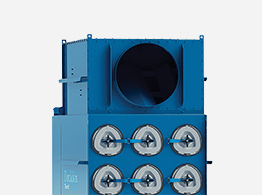In most industrial settings, dust will accumulate in a facility over time. Although many of us find the presence of dust irritating, we often assume it’s relatively harmless. This misconception is one of many that, if not addressed, can lead to very dangerous situations at work. The right conditions can increase the risk of combustible dust hazards occurring, including fires and explosions.
Hundreds of thousands of workplaces worldwide have some level of combustible dust risk, which is why it's so important to address common misconceptions. This article examines five of the more prevalent errors in thinking when it comes to combustible dust collection.
Misconception #1: Flame-Retardant (FR) Media Eliminates the Risk of an Event in a Dust Collector
Flame retardant or FR treatments adjust the properties of a filter media, such as cellulose or polyester, so that it will self-extinguish when removed from an external ignition source. Prior to manufacturing, proper testing of clean treated media will confirm it meets the design requirements and specifications.
In a continuous-duty dust collector, air and particulate are actively drawn toward the filter media resulting in a build-up of dust or a “dust cake” on the filter. Even when the filters are regularly cleaned, the entire dust cake is never fully dislodged from the surface of the filter media.
If an ignition source, such as a spark or ember enters the dust collector, it often comes in contact with the dust cake, not the actual filter media. In this case, the FR-treated media cannot self-extinguish because the dust cake acts as fuel for the ignition source, causing the dust and FR media to continue to combust.
Flame retardant media is most effective before the dust cake starts to form. Since combustible dust events can occur at any time, FR media is commonly used for processes that are more likely to have an ignition source come in contact with clean media, such as when new filters are installed in a collector. In metal fabrication processes, such as welding or grinding, FR media is typically one component of an overall mitigation strategy.

Misconception #2: Fans Start Fires
Since the dust collector fan tends to suffer the most damage during a fire, this misconception continues to live on. The truth is, most of the damage is concentrated at the fan inlet because it’s responsible for moving the air through this location, making it the hottest point in the system.
Most dust collectors operate under negative pressure, meaning the fan is located downstream of the filter media or on the clean side of the collector. During normal operation, the fan pulls air and particulate from upstream of the filter media into the system. If any external ignition sources, like embers or sparks are present, these can also get drawn into the dust collector leading to potential combustion events.
A fan that goes out of balance resulting in a spark, is more likely to exhaust the spark in the direction of the outlet. In this case, the bigger concern would be determining where the air is exhausting to.

Misconception #3: An Explosion Vent is All You Need
Explosion vents are an important component to any mitigation strategy, but they aren’t the only factor for preventing or controlling combustible dust events. NFPA also recognizes fires and flash-fires as combustible dust risks, and the equipment and/or solutions used to mitigate these events are different from what is typically used for explosions.
There are a myriad of dust collection technologies in the industry and many of them can effectively support various mitigation strategies. Choosing the right strategy for a specific application is critical to meeting design and performance objectives of your plan.
It’s important to understand the hazard you’re trying to mitigate. For example, when collecting pharmaceutical dust from a manufacturing process, a mitigation strategy that contains and suppresses an event may be more favorable than one that releases material to the outside environment. The dust, the process, employee safety, and the dust collector all need to be considered when choosing a strategy.
Misconception #4: There Are No Risks to Address With Dust Collectors Smaller Than Eight Cubic Feet
According to NFPA 652, a dust collector greater than eight cubic feet must be protected from a deflagration. As a result, many people assume that if they have a dust collector smaller than eight cubic feet, they won't have to be concerned about meeting NFPA requirements.
While this may seem like a straightforward guideline, it actually complicates things. The physical size of a dust collector does not change the combustible properties of the dust being generated. The risk of an event remains, it’s just more challenging to apply some mitigation equipment to a vessel of that size.
An explosion in dust collection equipment less than eight cubic feet can still cause injury to others or property damage in the surrounding area. When using smaller equipment, process owners need to consider the area around the equipment enclosure as part of their dust hazard assessment, making factors like housekeeping and worker practices more important.
Misconception #5: The Only Mitigation Choices Are the Prescriptive Actions Outlined in the NFPA Standards
NFPA standards are recommendations that are written like codes so they can easily be adopted by a city, state, or municipality. But they aren’t code per se. Within the NFPA standards, there are two acceptable methods of compliance:
- Prescriptive: Using methods outlined in the NFPA standards.
- Performance-based: An undefined alternative option that accomplishes the same objective as the prescriptive strategy.
When utilizing the performance-based method of compliance, facility owners can create their own unique mitigation strategy based on their knowledge of the process, risk assessment and dust hazard analysis. In many cases, an external expert may be brought in during the design or evaluation process to identify existing and additional safeguards. Documenting decisions and involving the local Authorities Having Jurisdiction (AHJs) in the process will help with gaining approval of the mitigation strategy.

Conclusion
Mistakes and misconceptions happen in all industries. In facilities handling combustible dust, misconceptions such as those above can lead to more severe consequences.
There are obviously other potential challenges that may arise across different industries and applications; however, those listed above have occurred time and time again, and seem to be an ongoing challenge with those generating, producing and handling combustible dust.
Continuous learning and willingness to work with experts can reduce risk and help ensure everyone goes home safely at the end of the day. See content at Dust Safety Journal.




